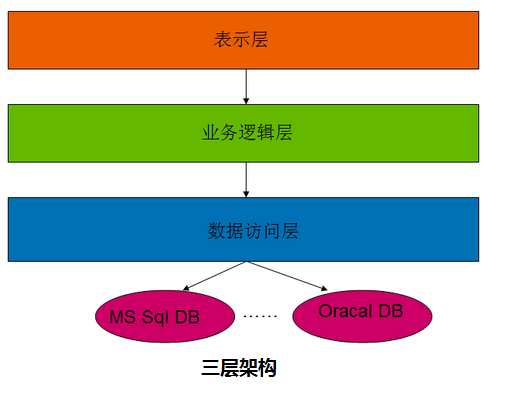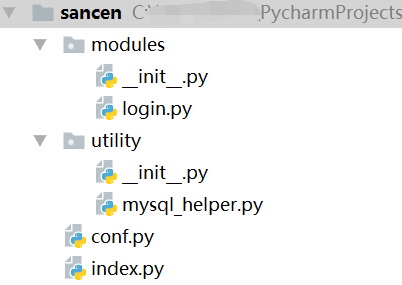三层架构(3-tier architecture) 通常意义上的三层架构就是将整个业务应用划分为:
表现层(Presentation layer)、业务逻辑层(Business Logic Layer)、数据访问层(Data access layer)
区分层次的目的即为了"高内聚低耦合"的思想
高内聚低耦合,是软件工程中的概念,是判断设计好坏的标准,主要是面向对象的设计,主要是看类的内聚性是否高,耦合度是否低。
三层架构,如下图:

1、表现层(UI):通俗讲就是展现给用户的界面,即用户在使用一个系统的时候他的所见所得。
2、业务逻辑层(BLL):针对具体问题的操作,也可以说是对数据层的操作,对数据业务逻辑处理。
3、数据访问层(DAL):该层所做事务直接操作数据库,针对数据的增添、删除、修改、查找等。
架构示例:

conf.py

1 #数据库连接配置文件 2 conn_dict=dict( 3 host='192.168.0.109', 4 user='root', 5 passwd='', 6 db ='TESTDB' 7 )
mysql_helper.py

1 import MySQLdb 2 import conf 3 4 class mysqlhelper(object): 5 def __init__(self): 6 self.__conn_dict=conf.conn_dict #定义一个私有字段__conn_dict,并将数据库字典配置赋值给它,外部无法直接访问 7 def get_info(self,sql,params): 8 conn=MySQLdb.connect(**self.__conn_dict) #使用两个*号可以将字典中的值作为参数传进来 9 cur=conn.cursor(cursorclass=MySQLdb.cursors.DictCursor) #创建游标 10 11 reCount=cur.execute(sql,params) 12 data=cur.fetchall() #获取所有信息 13 14 cur.close() 15 conn.close() 16 print data 17 return data 18 19 def get_oneinfo(self, sql, params): 20 conn=MySQLdb.connect(**self.__conn_dict) 21 cur=conn.cursor(cursorclass = MySQLdb.cursors.DictCursor) 22 try: 23 cur.execute(sql,params) 24 data=cur.fetchone() #获取一条信息 25 except: 26 print "出错了",sql,params 27 cur.close() 28 conn.close() 29 return data 30 31 32 def insert_info(self,sql,params): 33 conn = MySQLdb.connect(**self.__conn_dict) 34 cur = conn.cursor() 35 36 cur.execute(sql, params) 37 conn.commit() #提交插入语句 38 cur.close() 39 conn.close()
login.py

1 from utility.mysql_helper import mysqlhelper 2 3 class login(object): 4 def __init__(self): 5 self.__helper=mysqlhelper() #login类初始化,自动将mysqlhelper类赋给私有字段__helper 6 def get_info(self,firstname): 7 sql = "select * from emploeye where FIRST_NAME= %s" 8 params = (firstname,) 9 return self.__helper.get_info(sql,params) 10 def checkvalidate(self,firstname,password): 11 sql = "select * from emploeye where FIRST_NAME=%s and LAST_NAME=%s" 12 params = (firstname, password,) 13 return self.__helper.get_oneinfo(sql,params)
index.py

1 from modules.login import login 2 3 def main(): 4 user = raw_input('firstname:') 5 pwd = raw_input("lastname:") 6 admin=login() 7 result=admin.checkvalidate(user,pwd) 8 if not result: 9 print '用户名或密码错误' 10 else: 11 print '管理员%s进入后台登录界面' % user 12 13 if __name__ == '__main__': 14 main()
